Related Research Articles

CityRail was a passenger railway brand operated by the State Rail Authority from 1989 to 2003 and by RailCorp from 2003 to 2013 with services in and around Sydney, Newcastle and Wollongong, the three largest cities in New South Wales, Australia. It was established in January 1989 and abolished in June 2013 when it was superseded by Sydney Trains and NSW TrainLink.

The Sydney light rail network is a light rail/tram system serving the city of Sydney, New South Wales, Australia. The network currently consists of three passenger routes, the L1 Dulwich Hill, L2 Randwick and L3 Kingsford lines. The network comprises 42 stops and a system length of 24.7 km (15.3 mi), making it the second largest light rail network in Australia behind the tram network in Melbourne, Victoria. A fourth line, the 12 km (7.5 mi) Parramatta Light Rail in Sydney's west, is currently under construction and planned to open in August 2024.

Adelaide Metro is the public transport system of the Adelaide area, around the capital city of South Australia. It is an intermodal system offering an integrated network of bus, tram, and train services throughout the metropolitan area. The network has an annual patronage of 79.9 million, of which 51 million journeys are by bus, 15.6 million by train, and 9.4 million by tram. The system has evolved heavily over the past fifteen years, and patronage increased dramatically during the 2014–15 period, a 5.5 percent increase on the 2013 figures due to electrification of frequented lines.
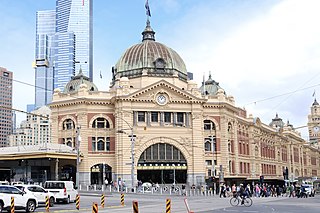
The Melbourne rail network is a metropolitan suburban and freight rail system serving the city of Melbourne, Victoria, Australia. The metropolitan rail network is centred around the Melbourne central business district (CBD) and consists of 221 railway stations across 16 lines, which served a patronage of 99.5 million over the year 2021–2022. It is the core of the larger Victorian railway network, with regional links to both intrastate and interstate rail systems.
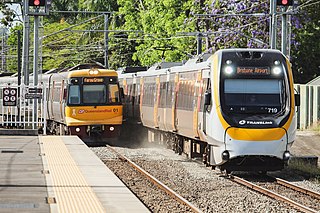
Rail transport in Australia is a component of the Australian transport system. It is to a large extent state-based, as each state largely has its own operations, with the interstate network being developed ever since Australia's federation in 1901. As of 2022, the Australian rail network consists of a total of 32,929 kilometres (20,461 mi) of track built to three major track gauges: 18,007 kilometres (11,189 mi) of standard gauge, 2,685 kilometres (1,668 mi) of broad gauge, and 11,914 kilometres (7,403 mi) of narrow gauge lines. Additionally, about 1,400 kilometres (870 mi) of 610 mm / 2 ft gauge lines support the sugar-cane industry. 3,488 kilometres (2,167 mi), around 11 per cent of the Australian heavy railways network route-kilometres are electrified.
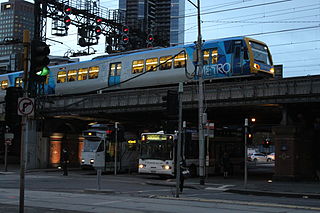
Transport in Melbourne, the state capital of Victoria, Australia, consists of several interlinking modes. Melbourne is a hub for intercity, intracity and regional travel. Road-based transport accounts for most trips across many parts of the city, facilitated by Australia's largest freeway network. Public transport, including the world's largest tram network, trains and buses, also forms a key part of the transport system. Other dominant modes include walking, cycling and commercial-passenger vehicle services such as taxis.

Transport in Sydney is provided by an extensive network of public transport operating modes including metro, train, bus, ferry and light rail, as well as an expansive network of roadways, cycleways and airports. According to the 2006 census, in terms of travel to work or study Sydney has the highest rate of public transport usage among the Australian capital cities of 26.3% with more than 80% of weekday trips to/from Central Sydney being made by public transport. According to the New South Wales State Plan, the state has Australia's largest public transport system. The public transport network is regulated by Transport for NSW.

Buses account for close to six per cent of trips each day in the city of Sydney, New South Wales, Australia, forming a key part of the city's public transport system. The network initially evolved from a privately operated system of feeder services to railway stations in the outer suburbs, and a publicly operated network of bus services introduced to replace trams in the inner suburbs. The bus network has undergone major reforms since the 2000s–2010s, with the New South Wales Government taking responsibility for route and fare-setting, opening contracts for most routes up to competitive tendering, and introducing more cross-suburban services.

The earliest trams in Australia operated in the latter decades of the 19th century, hauled by horses or "steam tram motors". At the turn of the 20th century, propulsion almost universally turned to electrification, although cable trams lingered in Melbourne. In cities and towns that had trams, they were a major part of public transport assets.

Railways in Perth, the capital city of Western Australia, have existed since 1881, when the Eastern Railway was opened between Fremantle and Guildford. Today, Perth has seven Transperth commuter rail lines and 75 stations.

A rail replacement bus service uses buses to replace a passenger train service on a temporary or permanent basis. The train service that is replaced may be of any type such as light rail, tram, streetcar, commuter rail, regional rail or heavy rail, intercity passenger service. The rail service may be replaced if the line is closed because of rail maintenance, a breakdown of a train, a rail accident or a strike action or to simply provide additional capacity or if the rail service is deemed not economically viable.

Transport for NSW (TfNSW) is a New South Wales government transport and road agency established on 1 November 2011. The agency is a different entity to the New South Wales Department of Transport, a department of the New South Wales Government and the ultimate parent entity of Transport for NSW.

NSW TrainLink is a train and coach operator in Australia, providing services throughout New South Wales and the Australian Capital Territory, along with limited interstate services into Victoria, Queensland and South Australia. Its primary intercity and regional services are spread throughout five major rail lines, operating out of Sydney's Central railway station.

Sydney Trains is the operator and brand name of the train network serving the Greater Sydney metropolitan area in New South Wales, Australia. The network is a hybrid urban-suburban rail system with a central underground core that covers 369 km (229 mi) of route length over 813 km (505 mi) of track, with 170 stations on eight lines.
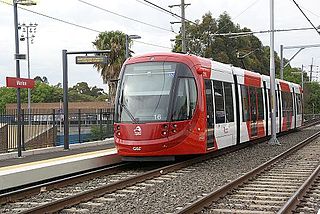
The Inner West Light Rail is a 12.8-kilometre (8.0 mi) light rail line in Sydney, New South Wales, Australia, running from Central railway station through the Inner West to Dulwich Hill and serving 23 stops. It is the original line of the Sydney light rail network, and was originally known as Sydney Light Rail. Light rail services on the line are now branded as the L1 Dulwich Hill Line.

The Sydney Metro is a fully automated rapid transit system in Sydney, New South Wales, Australia. The first component, the Metro North West Line, opened on 26 May 2019, running between Tallawong and Chatswood. It currently consists of 13 stations and 36 km (22.4 mi) of twin tracks, mostly underground. Work is progressing to extend this line from Chatswood to Bankstown as part of the City & Southwest project, which will run under Sydney Harbour and the Sydney Central Business District (CBD), with a scheduled 2025 completion. When completed, the entire line from Tallawong to Bankstown will have 66 km (41.0 mi) of twin tracks and 31 stations.
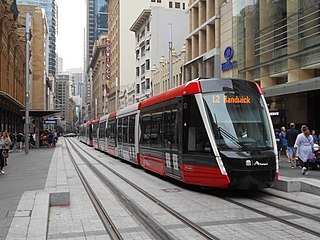
The CBD and South East Light Rail is a pair of light rail lines running between Sydney's central business district (CBD) and the south-eastern suburbs of Sydney, New South Wales, Australia. It consists of the L2 Randwick Line which runs between Circular Quay and Randwick, as well as the L3 Kingsford Line which runs between Circular Quay and Kingsford. Construction commenced in October 2015, with the L2 Randwick Line commencing services on the 14 December 2019 and the L3 Kingsford Line on the 3 April 2020. It is part of Sydney's light rail network.
The 2010s saw many developments relating to transport in the Australian city of Sydney, New South Wales. The decade saw a substantial investment in infrastructure, including a new airport, motorway projects, light rail lines, Australia's first metro system, the new Waratah fleet and the demise of the non-air conditioned S sets from the rail network. Planning and branding of public transport services became substantially more centralised.
References
- 1 2 Trainline 7 (PDF). Bureau of Infrastructure, Transport and Regional Economics. December 2019. pp. 44, 52. Retrieved 1 September 2020.
- ↑ "Sydney Trains Annual Report 2018-19" (PDF). Transport NSW. Retrieved 14 September 2020.
- ↑ Sydney Trains Network Map Transport NSW
- ↑ Train Statistics 2014 Transport for NSW page 6
- ↑ NSW, Transport for (4 December 2023). "Metro Patronage Monthly Comparison" . Retrieved 4 December 2023.
- ↑ "Light rail: Sydney finally embraces CBD tram line as patronage surges". amp.smh.com.au. Retrieved 20 September 2023.
- ↑ "Transport for New South Wales Train Patronage Monthly Figures". Bureau of Transport Statistics. Retrieved 11 September 2019.
- ↑ "ONE YEAR OF THE NEWCASTLE LIGHT RAIL". NBN News. Retrieved 20 September 2023.
- ↑ "PTV Annual Report 2018–19" (PDF). Public Transport Victoria. Retrieved 10 March 2020.
- ↑ Planning, Department of Transport and. "Patronage". dtp.vic.gov.au. Retrieved 20 September 2023.
- ↑ "Annual Report 2018-2019". V/Line. Retrieved 12 September 2019.
- ↑ "Public Transport Authority Transport performance". Public Transport Authority. Retrieved 12 September 2019.
- ↑ "Queensland Rail 2018–2019 Annual Financial Report" (PDF). Queensland Rail Limited. Retrieved 17 January 2020.
- ↑ "Department of Planning, Transport and Infrastructure 2018–19 Annual Report" (PDF). Department of Planning, Transport and Infrastructure. Retrieved 12 September 2019.